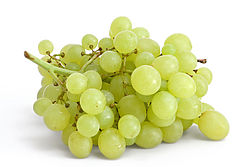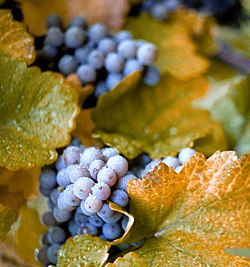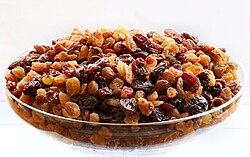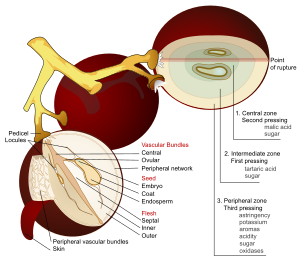Grape


A grape is a fruiting berry of the deciduous woody vines of the botanical genus Vitis. Grapes can be eaten raw or they can be used for making wine, jam, juice, jelly, grape seed extract, raisins, vinegar, and grape seed oil. Grapes are a non-climacteric type of fruit, generally occurring in clusters.
Template:Nutritional value
History
[edit]The cultivation of the domesticated grape began 6,000–8,000 years ago in the Near East.[1] The earliest archeological evidence for a dominant position of wine-making in human culture dates from 8,000 years ago in Georgia.[2][3]
Yeast, one of the earliest domesticated microorganisms, occurs naturally on the skins of grapes, leading to the innovation of alcoholic drinks such as wine. The earliest known production occurred around 8,000 years ago on the territory of Georgia.[4] During an extensive gene-mapping project, archaeologists analyzed the heritage of more than 110 modern grape cultivars, and narrowed their origin to a region in Georgia, where wine residues were also discovered on the inner surfaces of 8,000-year-old ceramic storage jars.[5] The oldest winery was found in Armenia, dating to around 4000 BC. By the 9th century AD the city of Shiraz was known to produce some of the finest wines in the Middle East. Thus it has been proposed that Syrah red wine is named after Shiraz, a city in Persia where the grape was used to make Shirazi wine. Ancient Egyptian hieroglyphics record the cultivation of purple grapes, and history attests to the ancient Greeks, Phoenicians and Romans growing purple grapes for both eating and wine production. The growing of grapes would later spread to other regions in Europe, as well as North Africa, and eventually in North America.
In North America, native grapes belonging to various species of the Vitis genus proliferate in the wild across the continent, and were a part of the diet of many Native Americans, but were considered by European colonists to be unsuitable for wine. Vitis vinifera cultivars were imported for that purpose.
Description
[edit]Grapes are a type of fruit that grow in clusters of 15 to 300, and can be crimson, black, dark blue, yellow, green, orange and pink. "White" grapes are actually green in color, and are evolutionarily derived from the purple grape. Mutations in two regulatory genes of white grapes turn off production of anthocyanins, which are responsible for the color of purple grapes.[6] Anthocyanins and other pigment chemicals of the larger family of polyphenols in purple grapes are responsible for the varying shades of purple in red wines.[7][8] Grapes are typically an ellipsoid shape resembling a prolate spheroid.
Grapevines
[edit]
Most grapes come from cultivars of Vitis vinifera, the European grapevine native to the Mediterranean and Central Asia. Minor amounts of fruit and wine come from American and Asian species such as:
- Vitis labrusca, the North American table and grape juice grapevines (including the Concord cultivar), sometimes used for wine, are native to the Eastern United States and Canada.
- Vitis riparia, a wild vine of North America, is sometimes used for winemaking and for jam. It is native to the entire Eastern U.S. and north to Quebec.
- Vitis rotundifolia, the muscadines, used for jams and wine, are native to the Southeastern United States from Delaware to the Gulf of Mexico.
- Vitis amurensis is the most important Asian species.
Distribution and production
[edit]According to the Food and Agriculture Organization (FAO), 75,866 square kilometers of the world are dedicated to grapes. Approximately 71% of world grape production is used for wine, 27% as fresh fruit, and 2% as dried fruit. A portion of grape production goes to producing grape juice to be reconstituted for fruits canned "with no added sugar" and "100% natural". The area dedicated to vineyards is increasing by about 2% per year.
There are no reliable statistics that break down grape production by variety. It is believed that the most widely planted variety is Sultana, also known as Thompson Seedless, with at least 3,600 km2. (880,000 acres) dedicated to it. The second most common variety is Airén. Other popular varieties include Cabernet Sauvignon, Sauvignon blanc, Cabernet Franc, Merlot, Grenache, Tempranillo, Riesling and Chardonnay.[9] Template:Stack begin
| Country | Area (km²) |
|---|---|
| Template:ESP | 11,750 |
| 8,640 | |
| Template:ITA | 8,270 |
| [[Image:Template:Country flag alias Turkey|border|25x20px|Template:Country alias Turkeyの旗]] Τουρκία | 8,120 |
| 20x20px|border|Bandera de Estados Unidos Estados Unidos | 4,150 |
| Template:IRN | 2,860 |
|
2,480 |
| Template:POR | 2,160 |
| Template:ARG | 2,080 |
| Template:CHI | 1,840 |
| border|22px Αυστραλία | 1,642 |
| 1,459 |
Template:Stack end Template:Stack begin
| Rank | Country | 2009 | 2010 | 2011 | 2012 |
|---|---|---|---|---|---|
| 1 |
| ||||
| 2 | 20x20px|border|Bandera de Estados Unidos Estados Unidos | 6,629,198 | 6,777,731 | 6,756,449 | 6,661,820 |
| 3 | Template:ITA | 8,242,500 | 7,787,800 | 7,115,500 | 5,819,010 |
| 4 | 6,101,525 | 5,794,433 | 6,588,904 | 5,338,512 | |
| 5 | Template:ESP | 5,535,333 | 6,107,617 | 5,809,315 | 5,238,300 |
| 6 | [[Image:Template:Country flag alias Turkey|border|25x20px|Template:Country alias Turkeyの旗]] Τουρκία | 4,264,720 | 4,255,000 | 4,296,351 | 4,275,659 |
| 7 | Template:CHI | 2,600,000 | 2,903,000 | 3,149,380 | 3,200,000 F |
| 8 | Template:ARG | 2,181,567 | 2,616,613 | 2,750,000 | 2,800,000 F |
| 9 | Template:IRN | 2,305,000 | 2,225,000 | 2,240,000 | 2,150,000 F |
| 10 | 1,748,590 | 1,743,496 | 1,683,927 | 1,839,030 | |
| — | World | 58,521,410 | 58,292,101 | 58,500,118 | 67,067,128 |
Table and wine grapes
[edit]
Commercially cultivated grapes can usually be classified as either table or wine grapes, based on their intended method of consumption: eaten raw (table grapes) or used to make wine (wine grapes). While almost all of them belong to the same species, Vitis vinifera, table and wine grapes have significant differences, brought about through selective breeding. Table grape cultivars tend to have large, seedless fruit (see below) with relatively thin skin. Wine grapes are smaller, usually seeded, and have relatively thick skins (a desirable characteristic in winemaking, since much of the aroma in wine comes from the skin). Wine grapes also tend to be very sweet: they are harvested at the time when their juice is approximately 24% sugar by weight. By comparison, commercially produced "100% grape juice", made from table grapes is usually around 15% sugar by weight.[11]
Seedless grapes
[edit]Seedless cultivars now make up the overwhelming majority of table grape plantings.[citation needed] Because grapevines are vegetatively propagated by cuttings, the lack of seeds does not present a problem for reproduction. It is an issue for breeders, who must either use a seeded variety as the female parent or rescue embryos early in development using tissue culture techniques.
There are several sources of the seedlessness trait, and essentially all commercial cultivators get it from one of three sources: Thompson Seedless, Russian Seedless, and Black Monukka, all being cultivars of Vitis vinifera. There are currently more than a dozen varieties of seedless grapes. Several, such as Einset Seedless, Benjamin Gunnels's Prime seedless grapes, Reliance and Venus, have been specifically cultivated for hardiness and quality in the relatively cold climates of northeastern United States and southern Ontario.[12]
An offset to the improved eating quality of seedlessness is the loss of potential health benefits provided by the enriched phytochemical content of grape seeds (see Health claims, below).[13][14]
Raisins, currants and sultanas
[edit]
In most of Europe and North America, dried grapes are referred to as "raisins" or the local equivalent. In the UK, three different varieties are recognized, forcing the EU to use the term "Dried vine fruit" in official documents.
A raisin is any dried grape. While raisin is a French loanword, the word in French refers to the fresh fruit; grappe (from which the English grape is derived) refers to the bunch (as in une grappe de raisins).
A currant is a dried Zante Black Corinth grape, the name being a corruption of the French raisin de Corinthe (Corinth grape). Currant has also come to refer to the blackcurrant and redcurrant, two berries unrelated to grapes.
A sultana was originally a raisin made from Sultana grapes of Turkish origin (known as Thompson Seedless in the United States), but the word is now applied to raisins made from either white grapes or red grapes that are bleached to resemble the traditional sultana.
Juice
[edit]
Grape juice is obtained from crushing and blending grapes into a liquid. The juice is often sold in stores or fermented and made into wine, brandy or vinegar. In the wine industry, grape juice that contains 7–23% of pulp, skins, stems and seeds is often referred to as "must". In North America, the most common grape juice is purple and made from Concord grapes while white grape juice is commonly made from Niagara grapes, both of which are varieties of native American grapes, a different species from European wine grapes. In California, Sultana (known there as Thompson Seedless) grapes are sometimes diverted from the raisin or table market to produce white juice.[15]
Health claims
[edit]French paradox
[edit]Comparing diets among Western countries, researchers have discovered that although the French tend to eat higher levels of animal fat, the incidence of heart disease remains low in France. This phenomenon has been termed the French paradox, and is thought to occur from protective benefits of regularly consuming red wine. Apart from potential benefits of alcohol itself, including reduced platelet aggregation and vasodilation,[16] polyphenols (e.g., resveratrol) mainly in the grape skin provide other suspected health benefits, such as:[17]
- Alteration of molecular mechanisms in blood vessels, reducing susceptibility to vascular damage
- Decreased activity of angiotensin, a systemic hormone causing blood vessel constriction that would elevate blood pressure
- Increased production of the vasodilator hormone, nitric oxide (endothelium-derived relaxing factor)

Although adoption of wine consumption is not recommended by some health authorities,[18] a significant volume of research indicates moderate consumption, such as one glass of red wine a day for women and two for men, may confer health benefits.[19][20][21] Emerging evidence is that wine polyphenols like resveratrol[22] provide physiological benefit whereas alcohol itself may have protective effects on the cardiovascular system.[23] More may be seen in the article the Long-term effects of alcohol.
Resveratrol
[edit]Resveratrol is found in widely varying amounts among grape varieties, primarily in their skins and seeds, which, in muscadine grapes, have about one hundred times higher concentration than pulp.[24] Fresh grape skin contains about 50 to 100 micrograms of resveratrol per gram.[25]
Anthocyanins and other phenolics
[edit]
Anthocyanins tend to be the main polyphenolics in purple grapes whereas flavan-3-ols (i.e. catechins) are the more abundant phenolic in white varieties.[26] Total phenolic content, a laboratory index of antioxidant strength, is higher in purple varieties due almost entirely to anthocyanin density in purple grape skin compared to absence of anthocyanins in white grape skin.[26] It is these anthocyanins that are attracting the efforts of scientists to define their properties for human health.[27] Phenolic content of grape skin varies with cultivar, soil composition, climate, geographic origin, and cultivation practices or exposure to diseases, such as fungal infections.
Red wine may offer health benefits more so than white because potentially beneficial compounds are present in grape skin, and only red wine is fermented with skins. The amount of fermentation time a wine spends in contact with grape skins is an important determinant of its resveratrol content.[28] Ordinary non-muscadine red wine contains between 0.2 and 5.8 mg/L,[29] depending on the grape variety, because it is fermented with the skins, allowing the wine to absorb the resveratrol. By contrast, a white wine contains lower phenolic contents because it is fermented after removal of skins.
Wines produced from muscadine grapes may contain more than 40 mg/L, an exceptional phenolic content.[24][30] In muscadine skins, ellagic acid, myricetin, quercetin, kaempferol, and trans-resveratrol are major phenolics.[31] Contrary to previous results, ellagic acid and not resveratrol is the major phenolic in muscadine grapes.
The flavonols syringetin, syringetin 3-O-galactoside, laricitrin and laricitrin 3-O-galactoside are also found in purple grape but absent in white grape.[32]
Seed constituents
[edit]Biochemical and preliminary clinical studies have demonstrated potential biological properties of grape seed oligomeric procyanidins.[33] For example, laboratory tests indicated a potential anticancer effect from grape seed extract.[34] According to the American Cancer Society, "there is very little reliable scientific evidence available at this time that drinking red wine, eating grapes, or following the grape diet can prevent or treat cancer in people".[35]
Grape seed oil from crushed seeds is used in cosmeceuticals and skincare products for perceived health benefits. Grape seed oil contains tocopherols (vitamin E) and high contents of phytosterols and polyunsaturated fatty acids such as linoleic acid, oleic acid and alpha-linolenic acid.[36][37][38]
Grape and raisin toxicity in dogs
[edit]The consumption of grapes and raisins presents a potential health threat to dogs. Their toxicity to dogs can cause the animal to develop acute renal failure (the sudden development of kidney failure) with anuria (a lack of urine production) and may be fatal.[39]
Grape therapy
[edit]Grape therapy, also known as ampelotherapy (Template:Ety), is a form of naturopathic medicine or alternative medicine that involves heavy consumption of grapes, including seeds, and parts of the vine, including leaves. Although there is some limited evidence of positive benefits from the consumption of grapes for health purposes, extreme claims, such as its ability to cure cancer, have been widely derided as “quackery”.
Religious significance
[edit]Template:See also In the Bible, grapes are first mentioned when Noah grows them on his farm (Genesis 9:20–21). Instructions concerning wine are given in the book of Proverbs and in the book of Isaiah, such as in Proverbs 20:1 and Isaiah 5:20–25. Deuteronomy 18:3–5,14:22–27,16:13–15 tell of the use of wine during Jewish feasts. Grapes were also significant to both the Greeks and Romans, and their god of agriculture, Dionysus, was linked to grapes and wine, being frequently portrayed with grape leaves on his head.[40] Grapes are especially significant for Christians, who since the Early Church have used wine in their celebration of the Eucharist.[41] Views on the significance of the wine vary between denominations. In Christian art, grapes often represent the blood of Christ, such as the grape leaves in Caravaggio’s John the Baptist.
Use in religion
[edit]Template:See also Grape juice, because of its non-alcoholic content, is commonly used by those Christians who oppose the partaking of alcoholic beverages, as the "cup" or "wine" in the Lord's Supper.[42]
The Catholic Church uses wine in the celebration of the Eucharist because it is part of the tradition passed down through the ages starting with Jesus Christ at the Last Supper, where Catholics believe the consecrated bread and wine literally become the body and blood of Jesus Christ, a dogma known as transubstantiation.[43] Wine is used (not grape juice) both due to its strong Scriptural roots, and also to follow the tradition set by the early Christian Church.[44] The Code of Canon Law of the Catholic Church (1983), Canon 924 says that the wine used must be natural, made from grapes of the vine, and not corrupt.[45] In some circumstances, a priest may obtain special permission to use grape juice for the consecration, however this is extremely rare and typically requires sufficient impetus to warrant such a dispensation, such as personal health of the priest.
Although alcohol is permitted in Judaism, grape juice is sometimes used as an alternative for kiddush on Shabbat and Jewish holidays and it has the same blessing as wine. Many authorities maintain that grape juice must be capable of turning into wine naturally in order to be used for kiddush. Common practice, however, is to use any kosher grape juice for kiddush.
Gallery
[edit]-
Flower buds
-
Flowers
-
Immature fruit
-
Grapes in Iran
-
Vineyard in the Troodos Mountains
See also
[edit]- Annual growth cycle of grapevines
- Propagation of grapevines
- Grape syrup
- Drakshasava, a traditional Ayurvedic tonic made from grapes
- List of grape varieties
Sources
[edit]- ^ This, Patrice; Lacombe, Thierry and Thomash , Mark R. (2006). "Historical Origins and Genetic Diversity of Wine Grapes" (PDF). Trends in Genetics. 22 (9): 511–519. doi:10.1016/j.tig.2006.07.008. PMID 16872714.
{{cite journal}}: CS1 maint: multiple names: authors list (link) - ^ McGovern, Patrick E. (2003). Ancient Wine: The Search for the Origins of Viniculture (PDF). Princeton University Press.
- ^ McGovern, P. E. "Georgia: Homeland of Winemaking and Viticulture".
- ^ Keys, David (2003-12-28) Now that's what you call a real vintage: professor unearths 8,000-year-old wine. archaeology.ws.
- ^ [1]. europesfinestwines.com (2011-12-14). Retrieved on 2012-07-10.[dead link]
- ^ Template:Cite pmid
- ^ Template:Cite pmid
- ^ Template:Cite pmid
- ^ "The most widely planted grape in the world". freshplaza.com.
- ^ "Production of Grape by countries". UN Food & Agriculture Organization. 2011. Retrieved 2014-02-12.
- ^ "Wine Grapes and Grape-y Wines". Retrieved 03/07/2010.
{{cite web}}: Check date values in:|accessdate=(help) - ^ Reisch BI, Peterson DV, Martens M-H. "Seedless Grapes", in "Table Grape Varieties for Cool Climates", Information Bulletin 234, Cornell University, New York State Agricultural Experiment Station, retrieved December 30, 2008
- ^ Template:Cite pmid
- ^ Template:Cite pmid
- ^ "Thompson Seedless Grape Juice". sweetwatercellars.com.
- ^ Template:Cite pmid
- ^ Template:Cite pmid
- ^ Alcohol, wine and cardiovascular disease. American Heart Association
- ^ Alcohol. Harvard School of Public Health
- ^ Template:Cite pmid
- ^ Template:Cite pmid
- ^ Template:Cite pmid
- ^ Template:Cite pmid
- ^ Jump up to: a b LeBlanc, MR (2005). "Cultivar, Juice Extraction, Ultra Violet Irradiation and Storage Influence the Stilbene Content of Muscadine Grapes (Vitis Rotundifolia Michx". PhD Dissertation. Louisiana State University.
- ^ Template:Cite pmid
- ^ Jump up to: a b Template:Cite pmid
- ^ Berry Health Berry Symposium Abstracts & Research from the 2007 International Berry Health Benefits Symposium, Berry Health Berry Symposium, June 2007
- ^ Resveratrol. Pennington Nutrition Series 2005 No. 7. pbrc.edu
- ^ Template:Cite pmid
- ^ Ector BJ, Magee JB, Hegwood CP, Coign MJ (1996). "Resveratrol Concentration in Muscadine Berries, Juice, Pomace, Purees, Seeds, and Wines". Am. J. Enol. Vitic. 47 (1): 57–62.
{{cite journal}}: CS1 maint: multiple names: authors list (link) - ^ Template:Cite pmid
- ^ Template:Cite pmid
- ^ Template:Cite pmid
- ^ Template:Cite pmid
- ^ "Grapes". American Cancer Society. 1 November 2011. Retrieved August 2013.
{{cite web}}: Check date values in:|accessdate=(help) - ^ Template:Cite pmid
- ^ Template:Cite pmid
- ^ Template:Cite pmid
- ^ Raisins/Grapes. The Merck Veterinary Manual
- ^ Grape Leaf Significance. Garden Guides. Retrieved on 2012-05-28.
- ^ Justin Martyr, First Apology, and Chapters LXV and LXVII of The Ante-Nicene Fathers.
- ^ "Why do most Methodist churches serve grape juice instead of wine for Holy Communion?". The United Methodist Church. Retrieved 2007-07-07.
- ^ "Catechism of the Catholic Church, 1413". Vatican.va. Retrieved 2012-02-01.
- ^ "The Real Presence of Christ in the Eucharist". Newadvent.org. 1909-05-01. Retrieved 2012-02-01.
- ^ "Altar wine, Catholic encyclopedia". Newadvent.org. 1907-03-01. Retrieved 2012-02-01.
Further reading
[edit]- Creasy, G. L. and L. L. Creasy. (2009). Grapes (Crop Production Science in Horticulture). CABI. ISBN 978-1-84593-401-9
- 20x15px|link=|alt= Wikiquote alberga frases célebres de o sobre Grape.
 Media related to Grapes at Wikimedia Commons
Media related to Grapes at Wikimedia Commons
Template:Viticulture Template:Tannin source Template:Bioenergy
- Pages using the JsonConfig extension
- CS1 maint: multiple names: authors list
- All articles with dead external links
- Articles with dead external links from March 2012
- Articles with invalid date parameter in template
- CS1 errors: dates
- Articles with hatnote templates targeting a nonexistent page
- Wikipedia pages with incorrect protection templates
- All articles with unsourced statements
- Articles with unsourced statements from April 2013
- Grape





